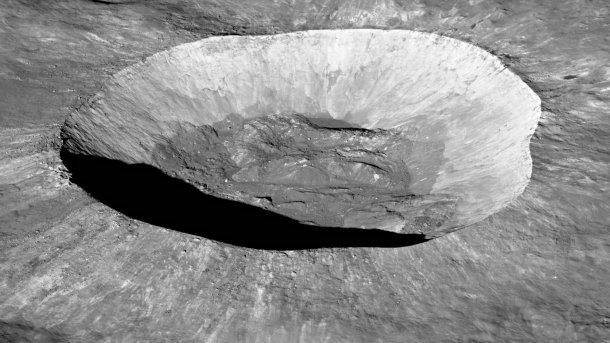Near-Earth asteroid Kamoʻoalewa: quasi-satellite tracked to lunar crater
Kamoʻoalewa is the most famous of the few quasi-satellites on Earth. A research group has now determined which lunar crater it probably came from.
The lunar crater Giordano Bruno
(Bild: NASA/Goddard/Arizona State University)
The most famous of Earth's so-called quasi-satellites not only comes from the moon, a research team has now apparently even succeeded in locating the crater that gave rise to the object called (469219) Kamoʻoalewa. As the group led by Yifei Jiao from Tsinghua University in Beijing explains, the work is based on a series of simulations. These showed that the celestial body must be the remnant of an impact that produced a lunar crater with a diameter of 10 to 20 km a few million years ago. In the end, all the data would only have fitted the lunar crater Giordano Bruno, which lies just behind the visible part of the moon's surface on the back of the Earth's satellite.
Sampling will provide answers
Kamoʻoalewa is one of less than a dozen known quasi-satellites on Earth. The asteroid, which measures around 50 meters in diameter, orbits the sun on an orbit that is very similar to that of the Earth. This makes the celestial body extremely difficult to observe; only for one week in April is it close enough to the Earth to be examined with the most powerful telescopes. The asteroid was only discovered in 2016 using technology at the Haleakalā Observatory in Hawaii. However, the object only achieved a certain degree of fame five years later when a research team from the University of Arizona discovered that Kamoʻoalewa probably originated from the moon.
The hypothesis about the origin of Kamoʻoalewa can be tested when the Chinese probe Tianwen-2 brings samples from the asteroid to Earth. The mission, originally prepared under the name ZhengHe, is scheduled to start next year. At the same time, more precise analyses of the lunar crater Gioardano Bruno could make it clear whether the asteroid is alone. Yifei Jiao's team has determined that up to three such celestial bodies could still be accompanying the Earth if the crater is only a few million years old. The longer ago the impact occurred, the less likely it is that other remnants the size of Kamoʻoalewa are still orbiting the sun.
If the reconstruction of Kamoʻoalewa's origin presented in the scientific journal Nature can be confirmed, it would not be the first time that a celestial body has been traced back to a very specific crater. Only a few years ago, the oldest and most famous Martian meteorite "Black Beauty" was traced back to a crater on the Red Planet. If Kamoʻoalewa was indeed knocked into space during the formation of the Gioardano Bruno crater, taking samples from Tianwen-2 would then also be a rare opportunity to obtain comparatively young material from beneath the surface of the moon.
(mho)
